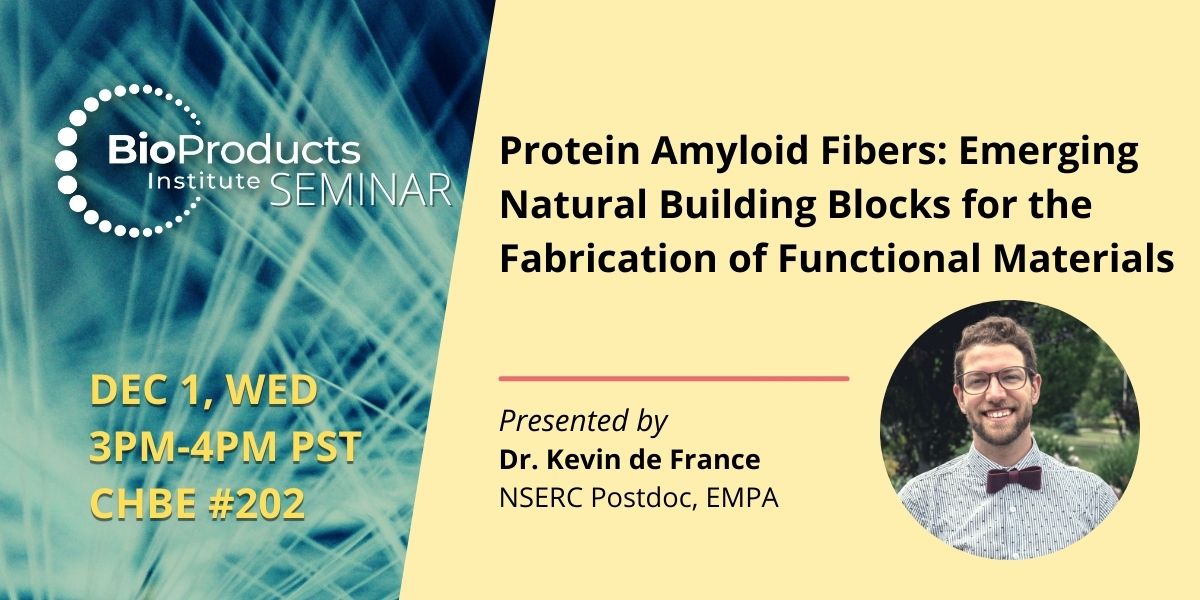BPI SEMINAR BY DR. KEVIN DE FRANCE
December 1, 2021, 12:00 am to 12:00 am
TITLE
Protein Amyloid Fibers: Emerging Natural Building Blocks for the Fabrication of Functional Materials
DATE & TIME
December 1st Wednesday 3PM-4PM PST
LOCATION
CHBE Room 202, 2360 East Mall, Vancouver, BC V6T 1Z3 (Sorry no Zoom link, In-person Only)
ABOUT THE EVENT
Join us to learn about fibrous proteins as building-blocks in the fabrication of functional materials! In this BPI seminar, Dr. Kevin De France will highlight the preparation and application of protein amyloid fibres.
ABOUT THE SPEAKER
Kevin (he/him) is an incoming Assistant Professor in the Chemical Engineering Department at Queen’s University in Kingston, where his lab will focus on the development of sustainable materials from natural building-blocks based on cellulose and protein. Kevin grew up in the small town of Waterdown, Ontario, later attending McMaster University and receiving his Bachelor’s degree in Chemical Engineering and Biosciences in 2014. He obtained his Ph.D. (also from McMaster) in Chemical Engineering in 2019, which focused on the design of structured cellulose nanocrystal composite hydrogels for biomedical applications, under the co-supervision of Dr. Emily Cranston and Dr. Todd Hoare. Kevin then joined the Cellulose & Wood Materials Lab at Empa – Swiss Federal Laboratories for Materials Science and Technology, where he currently works as an NSERC Postdoctoral Fellow under Dr. Gustav Nyström.
ABSTRACT
The development of high-performance sustainable bio-based materials as a practical replacement for non-renewable products undoubtedly represents one of the most significant challenges of the 21st century. Behind a wave of societal and regulatory pressure, interest in sustainable materials is rapidly growing, paving the way for fundamental research and commercial development in areas spanning the biomedical sector, packaging, energy storage devices, construction, and coatings. To this end, due to their natural abundance, functional diversity, and biocompatibility/biodegradability, proteins are well-suited as biomolecule building-blocks for the fabrication of functional materials. In nature, proteins exist in a semi-stable “native” folded conformation; however, proteins can also self-assemble into different conformations with alternative functionalities in response to various external factors. One such conformation is the amyloid state – a highly aggregated, fibrillar conformation stabilized by β-sheets.
In this seminar, protein amyloid fibers will be introduced, and discussed in the context of biological pathology, functionality, and practical application, with an emphasis on understanding key structure-function relationships in the design of different materials. In particular, the use of common proteins such as lysozyme and bovine serum albumin and various synthetic pathways for the preparation of amyloid fibers are highlighted, describing their effects on kinetics of self-assembly, fiber morphology, and surface charge. Furthermore, the incorporation of amyloid fibers into composite materials such as films, bioadhesives, and aerogels are covered, demonstrating synergistic improvements in material properties such as mechanical strength, adhesive potential, and chiral nematic ordering. Taken together, the design and engineering of sustainable materials such as protein amyloid fibers represents a significant milestone towards addressing key challenges within the biomedical sector and beyond.
